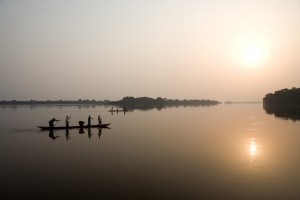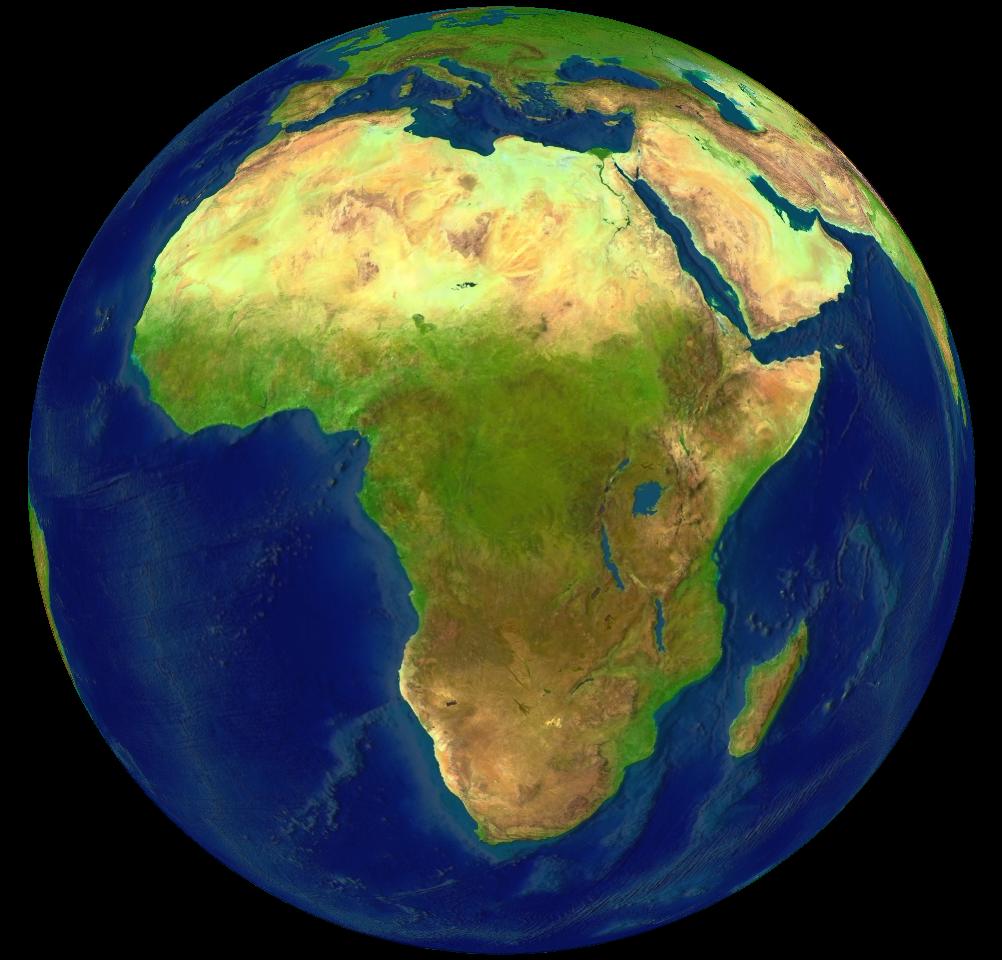The environmental crisis, global capital, colonization, war, and destruction all meet head on in Africa in general, and the Democratic Republic of the Congo (DRC) in particular...and those of us, like you and me, just aren't doing a hell of a lot about any of it. Not really.
It is obvious that the Developed countries and global capital are doing all they can to re-enter and control as much of Africa as possible, as quickly as possible right now. They want the resources mostly. They desperately want the resources and they don't much care how much damage they do or who is in the way. Africa has a large quantity of natural resources including oil, diamonds, gold, iron, cobalt, uranium, copper, bauxite, silver, petroleum and cocoa beans, but also woods and tropical fruits. Much of its natural resources are undiscovered or barely harnessed. Global Capital in the form of the developed countries (and the so called developing countries) are making sure the value from these resources are heading their way and doing nothing for the people of Africa themselves.
For more than two decades the United States and western based capital has been increasingly escalating military and economic penetration of Africa.
As Abayomi Azikiwe writes at Pambazuka News:
The presence of U.S. military and intelligence forces in Africa is designed to bolster the strategic mineral and territorial interests of Wall Street. Africa is now supplying greater amounts of oil, natural gas and other essential minerals to economic interests of the ruling class.
With the growing role of the People’s Republic of China on the continent, Washington and Wall Street are concerned that they will lose their post-World War II advantage in Africa. Hence due to the declining economic influence of the U.S., the capitalist are relying more on aggressive military and intelligence operations to undermine Africa’s long term interests which are more in line with other continental states as well as other geo-political regions of the world including Asia, the Middle East and Latin America.
Garikai Chengu writes at Systemic Capital.com,
....Africa is a paradox that underscores the ongoing power of financial imperialism. She is spectacularly rich, yet the natural capital that is extracted from above and below her children’s feet continues to enrich, not Africans, but the people who facilitate Africa’s impoverishment: Western capitalists.
...Neo-liberalism is unquestionably the greatest cancer spreading across the African continent. Neo-liberalism is the promotion of a combination of counter-developmental economic policies, such as privatisation, austerity and structural adjustment that put the interests of foreign capital over local labour.
Meanwhile, highlighting the fact that we are talking about GLOBAL capital here is the fact that Brazil, Russia, India, China and South Africa (BRICS) are surely not hapless innocents in all this. The question always being is it the State, is it Capital, who the hell is it.
Patrick Bond puts it this way at Links:
The BRICS agenda of relegitimising neoliberalism not only reinforces North American power, of course. In each case, the BRICS countries’ control of their hinterlands for the sake of regional capitalist hegemony was another impressive feature of sub-imperialism, especially in South Africa’s case....
...South African, US, European, Australian and Canadian firms have been joined by major firms from China, India and Brazil in the region. Their work has mainly built upon colonial infrastructural foundations – road, rail, pipeline and port expansion – for the sake of minerals, petroleum and gas extraction. BRICS appears entirely consistent with facilitating this activity, especially through the proposed BRICS Bank...
...The eco-destructive, consumerist-centric, over-financialised, climate-frying maldevelopment model throughout the BRICS works very well for corporate and parastatal profits, especially for Western capital, but is generating repeated crises for the majority of its people and for the planet.
The media likes to portray Africa as a continent surviving on the handouts of the West. The exact opposite is more the case. As Garikai Chengu explains,
...it is the West that is reliant on African handouts. These handouts come in many and varied forms. They include illicit flows of resources, the profits of which invariably find their way into the West’s banking sector via strings of tax havens (as thoroughly documented in Nicholas Shaxson’s Poisoned Wells). Another is the mechanism of debt-extortion whereby banks lend money to military rulers (often helped to power by Western governments, such as the Congo’s former President Mobutu), who then keep the money for themselves (often in a private account with the lending bank), leaving the country paying exorbitant interest on an exponentially growing debt.
...Recent research by Leonce Ndikumana and James K Boyce found that up to 80 cents in every borrowed dollar fled the borrower nation in ‘capital flight’ within a year, never having been invested in the country at all; whilst meanwhile $20billion per year is drained from Africa in ‘debt servicing’ on these, essentially fraudulent, ‘loans’.
Think none of this has a direct effect on internal wars, on environmental collapse, on the very lives today of the people of Africa. Hopefully, you are smart enough to think no such thing.
Meanwhile I direct you to this interesting article from Ceasefire.
Africlimate | The DRC: Beyond the atrocities, an emerging environmental crisis
The Democratic Republic of Congo (DRC) is a region of Africa plagued by tragedy. This wasn’t always so: the thriving Kingdom of Kongo (which also includes modern Angola) enjoyed good trading relations with Portugal in 1482, before colonisation and the transatlantic slave trade. However, when civil war – instigated by the Portuguese – provided an opportunity for Europeans to purchase prisoners of war as slaves, this thriving civilisation and surrounding regions began a drawn-out and tempestuous descent. The civil war forced Afonso I, King of Kongo (DR Congo) to write to kings Manuel I and João III of Portugal in 1526 to protest:
‘Each day the traders are kidnapping our people – children of this country, sons of our nobles and vassals, even people of our own family. This corruption and depravity are so widespread that our land is entirely depopulated. We need in this kingdom only priests and school teachers, and no merchandise, unless it is wine and flour for Mass. It is our wish that this Kingdom not be a place for the trade or transport of slaves’.
From 1885, what was then called the Belgian Congo was carved out and bestowed upon King Leopold for mining rubber, eventually facilitating the automobile industry in Belgium and its incorporation into the industrial revolution. Despite widespread anticolonial resistance, imperial exploitation continues to this day – diamonds, gold, copper, cobalt, zinc, cassiterite (used in food packaging) and coltan (tantalum for making technological equipment) are extracted through European and US funding and support of civil conflict.
The DRC is a country of 60 million people, and equals in size the combined territorial expanse of Germany, the Netherlands, Belgium, Luxembourg, Austria, France, Spain, Portugal, Gibraltar and Italy. No less than two-thirds of its population rely on the rainforest in one way or another for food, medicine and shelter, and the cultures of many communities are founded on their relationship with the natural environment. The Congo basin rainforest in the DRC covers around two-thirds of the African equatorial forest. The African equatorial rainforest stretches from East to West Africa and is the second largest on earth after the Amazon. It extends to a large areas of Gabon, Cameroon, Equatorial Guinea, the Central African Republic and the Republic of Congo itself.
In spite of all its natural wealth, the African equatorial rainforest is under sustained threat, especially the areas across Central Africa which cover some 50 million hectares, an area the size of Spain. Food shortages and climate change are just some of the problems the world faces. The rainforest has the potential to help solve these crises through the judicious use of the resources possessed by the immense wealth of biodiversity. Forest elephants roam the area as do three species of great ape: gorillas, chimpanzees and bonobos. Animals and birds such as okapi and the Congo peacock are found nowhere else. And, as with all large forest areas, the Congo plays a vital role in regulating climate, both locally and globally. Efforts to preserve what remains of these areas are being hampered by a generational scramble for the country’s resources.
It is difficult to estimate precisely how many Congolese in Europe are refugees or asylum seekers. More than 400,000 Congolese refugees currently remain outside the DRC according to UNHCR statistics. The UNHCR report claims that, since the beginning of 2012, ethnic tensions and inequitable access to land have led to renewed violence in the east and north-east of DRC, resulting in the displacement of more than 2.2 million people inside the country. In addition, almost 70,000 people have crossed the border to neighbouring countries such as Uganda and Rwanda.
The 2009 report by UN-commissioned experts said UN involvement had done nothing to quell the violence – with rebels continuing to kill and plunder natural resources with impunity, and claims that the rebels are supported by an international network stretching through Africa to Western Europe and North America. Nevertheless, an earlier UN report in 2001 implicated about 100 multinational companies who rapaciously scrambled and looted the unaccountable wealth from the DRC rainforest. This firms include: Barclays Bank of the UK, Freeport-McMoRan Copper & Gold Inc, of the US, Banro Mining Company of Canada, Anglo Gold Ashanti Limited of South Africa and the infamous De Beers Groups. These companies were accused by the UN of financing rebels and exchanging ammunition for access to mineral resources and secure landing fields for their small planes to loot the wealth of the DRC rainforest. Sadly, the United States and the UK government forced the UN Security Council to back down in their attempt to prosecute these corporations. By 2008, over 8 million were dead, and at the time of writing, no source in the world can give an exact estimate of the fatalities.
DR Congo Equatorial rainforest and the danger of uncontrollable natural resources mining
According to an article published in the Proceedings of the National Academy of Sciences (PNAS) in 2011, it is estimated that sub-Saharan Africa’s forests contain 44-66 billion tons of carbon. Unlike other tropical forest regions, nearly three-quarters of Africa’s forests are distributed in woodland savannas and dry forests that contain less than 100 tons of carbon per hectare. Extremely carbon-dense forests, which store more than 350 tons of carbon in aboveground biomass per hectare, account for 8.7 percent of sub-Saharan Africa’s total stored carbon.
Overall, African forests store the least amount of carbon per hectare of any region, averaging 69-117 tons per hectare. Asia is the highest, averaging 125-174 tons per hectare per hectare, followed by the tropical Americas, which averages 87-132 tons per hectare. Unsurprisingly, the forests of the Democratic Republic of Congo which are the most extensive and store the most carbon of any African country, accounting for 26-37 percent of forest cover and 38-56 percent of carbon. Three other Congo Basin countries — Cameroon, Republic of Congo, and Central African Republic — follow.
 DRC rainforest deforestation rates since 1990 have been in the lowest of any major forest region in the world. However there are still a number of threats to the health of the Congo rainforest and its residents. The biggest drivers of deforestation in the Congo rainforest over the past 20 years have been small-scale subsistence agriculture, clearing for charcoal and fuel wood to domestically generate energy for cooking and lighting, urban expansion and mining.
DRC rainforest deforestation rates since 1990 have been in the lowest of any major forest region in the world. However there are still a number of threats to the health of the Congo rainforest and its residents. The biggest drivers of deforestation in the Congo rainforest over the past 20 years have been small-scale subsistence agriculture, clearing for charcoal and fuel wood to domestically generate energy for cooking and lighting, urban expansion and mining.
International industrial logging has been the biggest driver of forest degradation. However it’s important not to understate the impact of logging in the region. Logging roads have opened up vast areas of the Congo to commercial hunting, leading to a poaching epidemic in some areas and a more than 60 percent drop in the region’s forest elephant population in less than a decade. Furthermore, logging roads have provided access to speculators and small-holders who clear land for agriculture.
Looking forward, the biggest threats to the Congo rainforest come from international industrial logging and conversion for large-scale agriculture. Some environmentalists fear that the Congo could be on the verge of a massive increase in deforestation for palm oil, rubber, and sugar production.
In 2002 the Democratic Republic of Congo (DRC) announced a moratorium on commercial logging in a bid to save rapidly falling forests, however a new report by Global Witness alleges that industrial loggers are finding a way around the logging freeze. Through unscrupulous officials, foreign companies are abusing artisanal permits—meant for local community logging—to clear-cut wide swathes of tropical forest in the country. These logging companies are often targeting an endangered tree—wenge (Millettia laurentii)—largely for buyers in China and Europe.
Another fast growing issue of deforestation of the Congo rainforest are industrial oil palm plantations which are spreading from Malaysia and Indonesia to the Congo raising fears about further social conflict over land tenure, compeling the local residence who depend on the rainforest land for subsistence farming to emigrate.
A new report by The Rainforest Foundation UK (RFUK) 2013, dramatically entitled The Seeds of Destruction, announces that new palm oil plantations in the Congo rainforest will soon increase fivefold to half a million hectares, an area nearly the size of Delaware. But conservationists warn that by ignoring the lessons of palm oil in Southeast Asia, this trend could be disastrous for the region’s forests, wildlife, and people:
“Governments of Congo Basin countries have handed out vast tracts of rainforest for the development of palm oil with apparently little or no attention to the likely impacts on the environment or on people dependent on the forest” (Simon Counsell, Executive Director of the Rainforest Foundation UK)
The palm tree used to produce palm oil originated in Africa, so production in the Congo Basin isn’t new. But industrial palm oil production involving massive plantations is a recent development for the region. The approach, modeled after operations in Southeast Asia, raises concerns among environmentalists who argue that palm oil has been a disaster for the forests of Malaysia and Indonesia. Indeed, scientific research has found that between 1990 and 2000, 86 percent of all deforestation in Malaysia was for palm oil.
The largest palm oil developer in the Congo Basin is currently Malaysian-owned Atama Plantations SARL, which is working to establish a 180,000-hectare (450,000-acre) plantation in the Republic of Congo. But the entire enterprise is masked by a complete lack of transparency is just one of the endless list of agent of deforestation of DR Congo forest and forece displacement of its people.
New Entrant in to the scramble for DRC
Although the war is waning the scramble still rages on. The latest international entrant amidst the scramble is China. In 2008, Chinese businesses signed $9bn deal with DRC. A massive state-owned firm based in Beijing, the China Railway Engineering Corporation, or CREC deployed its Chinese engineers and advance team of surveyors using global positioning tools taking satellite readings to plot the exact course of a road that’s about to be built in the region. The deal planned to give DRC $6bn of desperately needed infrastructure – about 2,400 miles of road, 2,000 miles of railway, 32 hospitals, 145 health centres and two universities. In return, China gets a slice of DR Congo’s precious natural resources to feed its booming industries – 10m tonnes of copper and 400,000 tonnes of cobalt.
China has surpassed the US as Africa’s largest trading partner with trade of US$90 billion in 2009, compared with $86 billion for the US and foreign direct investments of over $50 billion. Bilateral trade topped $160 billion in 2011 and is expected to reach $200 billion this year. In addition, China has proposed or committed about $101 billion to commercial projects in Africa since 2010, of which construction and natural resource deals total approximately $90 billion. However, the whole arithmetic of the deal unfairly favours the Chinese. At current world prices for copper and cobalt, the Chinese side of the joint venture will make a colossal overall profit of about $42bn after all the investment’s been paid.
Being unable to compete economically with Beijing, Washington is once again turning to militarism to secure its advantage. As Mali demonstrates, and the ruinous war against Libya in 2011, this approach should be seen as a pointer for the future. The silent war in the DRC has claimed the lives of millions rooted in conflicts over strategic resources in which the rival imperialist powers invariably play their part more or less openly.
In 2011, according to a study by Dr Stephen Burgess, a Zimbabwean-born associate professor at the US Air War College, in his report titled ‘Sustainability of Strategic Minerals in Southern Africa and Potential Conflicts and Partnerships’, the US should move quickly to secure Southern Africa’s uranium, manganese, platinum, chrome, coltan (columbite and tantalum) and rare earth minerals for America’s industrial needs and for its military as well as maintenance of weapons systems. The study focuses on resource accessibility in the DRC, Namibia, South Africa, Zambia and Zimbabwe and draws parallels with the 1880s scramble for Africa.
To triumph in this new scramble, Burgess notes, ‘all instruments of (US) power’ must be deployed. Washington will enlist the services of the Department of Defence, the National Security Agency and the Africa Command (AFRICOM) to secure Southern Africa’s resources. DRC in particular for the US, is viewed as the source to quench America’s thirst for cobalt, uranium, coltan (columbite and tantalum), tungsten, tin, and rare earth minerals. In particular, the US government is concerned about access to ‘defence critical resources’. This requires increased levels of engagement with the African countries concerned, using all the instruments of American power and working with American and Western mining companies, as well as engagement with China and Chinese companies.
Conclusion
‘When two elephants fight, it is the grass that bears the brunt of the upheaval’ a Yoruba adage. On the ground in DRC, while power politics is played out across the African continent over natural resources, the mainstream media under-report or mis-report the atrocities facilitated by capital, led by the US and its allies, with the help of their puppets and cronies on the ground. As always, it is the ordinary Congolese who suffers most. The human cost of war and the destruction of environments essential for life both in the region and across the planet, are often presented as little more than collateral damage. We can easily neglect how our survival is dependent on the environment regardless of whether you live in the ‘concrete jungle’ or in the country side.
The interconnected nature of the planet’s complex ecosystems makes linking the issues of environmental degradation with modern imperialism an imperative for the progressive left based in the West, as it is and always has been for progress movements in the Global South. To build a movement which can not only defeat imperialist capitalism, but to maintain a healthy planet fit for habitation, climate justice and anti-imperialism must be understood as part of the same collective struggle.
Africlimate is an environmental project of the Hear Alkebu-lan* community group.




No comments:
Post a Comment